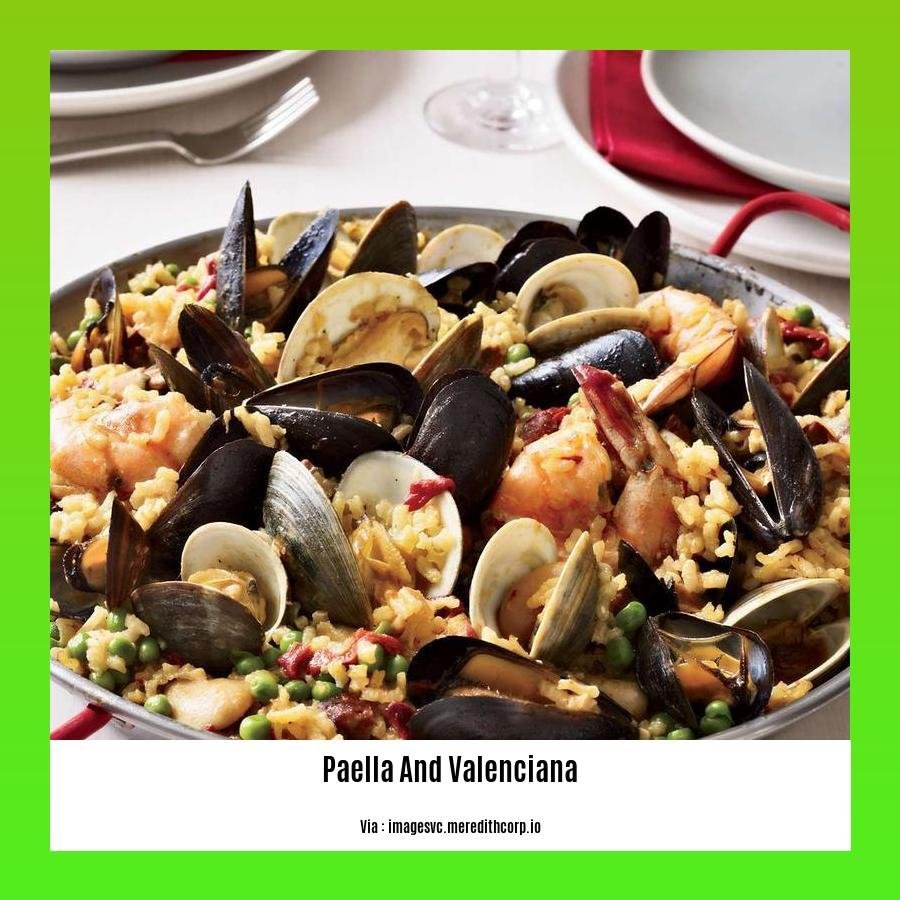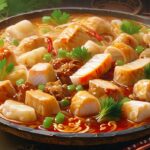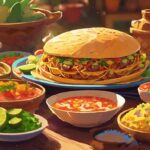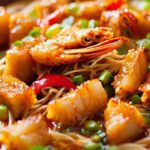Deciphering the Distinction: Unveiling the Difference between Paella and Valenciana
Join us on a culinary exploration as we unravel the intriguing differences between paella and Valenciana, two renowned Spanish rice dishes. As we delve into the cultural significance, distinct ingredients, and unique cooking methods of each dish, we aim to shed light on what sets them apart. With years of experience in gastronomy and an unwavering passion for regional cuisine, our insights promise to provide a comprehensive understanding of these beloved Spanish delicacies. So, let’s embark on a flavorful journey into the heart of paella and Valenciana, unraveling their nuances along the way.
Key Takeaways:
Arroz Valenciana and paella are two traditional Spanish dishes that share similar ingredients but differ in taste and preparation methods.
Arroz Valenciana is made with bomba rice, chicken broth, chicken, and rabbit, while paella Valenciana is cooked over an open flame using the same ingredients.
Glutinous rice, also known as malagkit rice, is not typically used for making paella, despite its similar qualities to traditional paella rice.
Paella is baked and cooked over an open flame, while risotto is cooked on the stove. Both dishes feature unique ingredients such as saffron, wine, seafood, vegetables, and spices, but the main difference lies in the cooking method and specific ingredients used.
Difference between paella and Valenciana
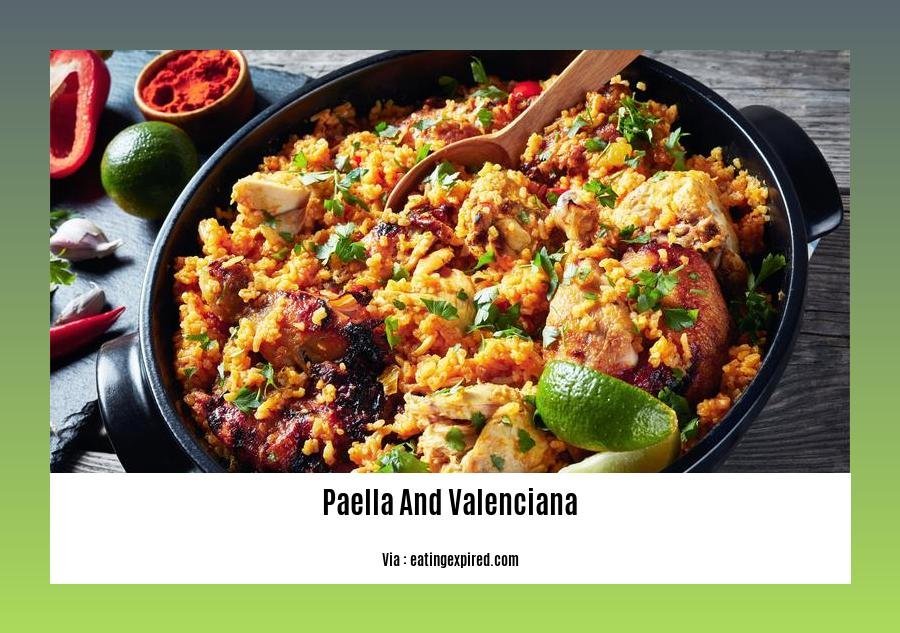
If you’ve ever explored Spanish cuisine, you might have come across two popular rice dishes – paella and Valenciana. While they may seem similar at first glance, there are distinct differences that set them apart. In this article, we will delve into the ingredients, cooking methods, and cultural significance of these two dishes, so you can fully understand the distinction between paella and Valenciana.
The Ingredients that Set them Apart
Both paella and Valenciana share some common ingredients, but it’s the variations that make them unique. Paella Valenciana typically includes bomba rice, chicken broth, chicken, and rabbit as the star proteins, while Arroz Valenciana combines rice, usually bomba rice, with chicken broth, chicken, and rabbit. As you can see, the main difference lies in the name itself – paella typically refers to the cooking vessel, whereas Arroz Valenciana is the name of the dish.
Cooking Techniques: Open Flame vs. Stove
Another crucial distinction between paella and Valenciana is the cooking method. Paella is traditionally prepared over an open flame using a special wide shallow pan called a paellera. This allows for even heat distribution and the formation of a socarrat, a crispy caramelized layer of rice that adds depth of flavor to the dish. On the other hand, Valenciana is typically cooked on the stove, allowing for a more controlled cooking process.
Regional Variations and Cultural Significance
Both paella and Valenciana have deep roots in Spanish culinary traditions, particularly in the Valencia region. In Valencia, paella is considered a symbol of communal gathering, often prepared outdoors during festivals and celebrations. Valenciana, on the other hand, is a dish that has been passed down through generations, showcasing the traditional flavors and techniques of the region. These dishes represent the rich cultural heritage and culinary legacy of Valencia.
Can Glutinous Rice be Used for Paella?
A common question that arises when discussing paella is whether glutinous rice can be used as a substitute. Glutinous rice, also known as malagkit rice, shares some qualities with the rice used in paella, but it is not typically used in traditional forms of paella. The use of bomba rice or another short-grain rice variety is preferred, as it absorbs the flavors of the ingredients while maintaining its shape and texture.
The Difference between Paella and Risotto
While we’re on the topic of rice dishes, it’s worth mentioning the difference between paella and risotto. While both dishes incorporate novel ingredients such as saffron, wine, seafood, vegetables, and special spices, the main difference lies in the cooking method and specific ingredients used. Paella is typically baked and cooked over an open flame, whereas risotto is cooked on the stove, with a slow addition of liquid to create a creamy texture.
In summary, paella and Valenciana may share some similarities in ingredients, but they are distinct dishes with their own unique preparation methods, cultural significance, and regional variations. Understanding the difference between paella and Valenciana allows you to appreciate the nuances of Spanish cuisine and make informed choices when encountering these dishes in the future. So, the next time you have the opportunity to savor these delightful rice dishes, you can truly savor the flavors and traditions they represent.
Create an active internal link along with the anchor and URL:
Detoxify everclean 5 day cleanse review
Detoxify green clean how long does it last
Distinct cooking techniques for each dish
When it comes to Spanish cuisine, two popular rice dishes often come to mind: paella and Valenciana. While these dishes may seem similar at first glance, their cooking techniques set them apart. In this article, we will explore the distinct cooking techniques for each dish, shedding light on their unique flavors and textures.
The technique behind Paella
Let’s start with paella, a beloved rice-based dish originating from the region of Valencia, Spain. Paella showcases vibrant flavors and textures that are achieved through specific cooking methods. To experience an authentic paella, one must visit Valencia, where the dish is widely available.
One of the key aspects of paella is the pan in which it is cooked. A traditional paella must be prepared in a large, shallow pan called a paellera. This wide and shallow pan allows for even heat distribution, resulting in a perfectly cooked dish.
When it comes to the cooking process, paella is traditionally cooked over an open flame. This method infuses the rice and ingredients with smoky flavors, adding depth to the dish. The rice is first sautéed with olive oil and aromatic ingredients such as onion and garlic. Then, a flavorful broth, usually made with chicken or seafood, is added.
Unlike risotto, another rice dish, paella does not require constant stirring. Instead, it is cooked to perfection without disturbing the delicate balance of ingredients. This technique allows the rice to absorb the flavors of the broth while maintaining its distinct grainy texture.
Valenciana’s unique cooking approach
On the other hand, Valenciana follows a different cooking technique. Valencian paella is made with rice grown in the l’Albufera region of Valencia and cooked with local farm ingredients. It is a combination of rice, meat, and vegetables, resulting in a hearty and flavorful dish.
To experience an authentic Valencian paella, one must stick to the traditional method. A real Valencian paella must be cooked in a pan with two handles over an open flame. This direct heat source enhances the flavors and textures of the dish, creating a culinary masterpiece.
Unlike paella, Valenciana is typically cooked on the stove. The process involves sautéing the meat, usually chicken and rabbit, with aromatic ingredients such as onions and peppers. Once the meat is cooked, the rice is added and cooked to perfection, absorbing the flavors of the meats and spices.
Valenciana’s cooking technique allows for a rich integration of flavors, resulting in a delicious and satisfying dish that represents the cultural heritage and culinary legacy of the Valencia region.
Key Takeaways:
- Paella and Valenciana are two popular rice dishes in Spanish cuisine with distinct cooking techniques.
- Paella is traditionally cooked over an open flame in a shallow paellera, while Valenciana is cooked on the stove in a pan with two handles.
- Paella involves sautéing the rice and adding flavorful broth, while Valenciana incorporates sautéed meat and vegetables before adding the rice.
- The open flame cooking method adds smoky flavors to paella, while the stove cooking method allows for a rich integration of flavors in Valenciana.
Sources:
1. The Cooking Facts
2. Kitchen Him
Regional Variations and Cultural Significance
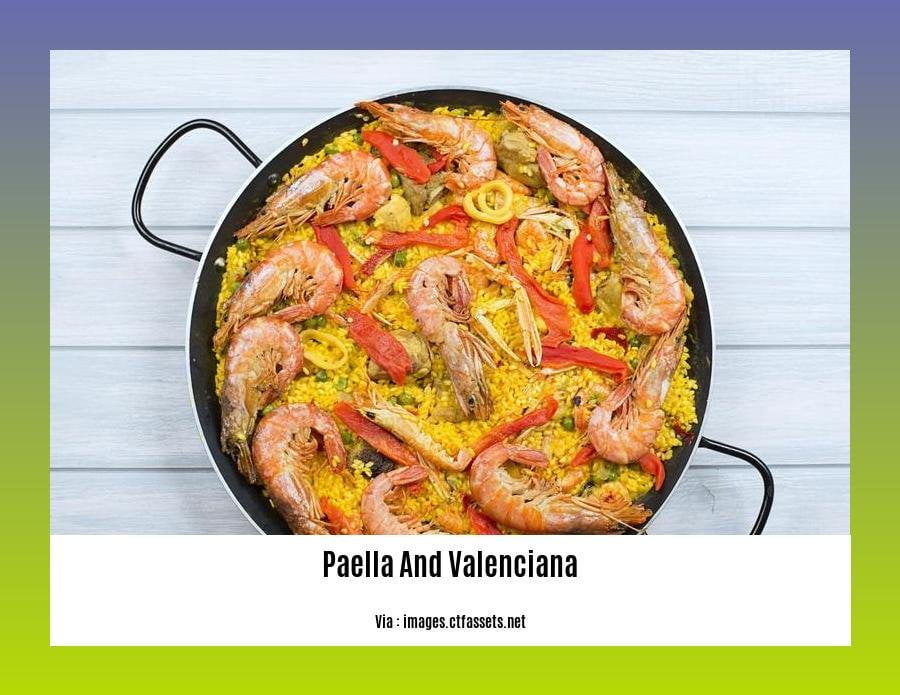
Key Takeaways:
– Paella and Valenciana are two iconic Spanish rice dishes, each with its own unique regional variations and cultural significance.
– Paella originated in the rice-growing areas on Spain’s Mediterranean coast, particularly associated with the Valencia region.
– The dish is traditionally made with saffron-flavored rice and can include meats, seafood, and vegetables.
– Valenciana is the name of the rice dish, while paella refers to the cooking vessel.
– Authentic paella Valenciana includes bomba rice, chicken broth, chicken, and rabbit, while Arroz Valenciana combines rice, usually bomba rice, with chicken broth, chicken, and rabbit.
– Both dishes have deep roots in Spanish culinary traditions and represent the cultural heritage and culinary legacy of the Valencia region.
– Paella has been officially recognized for its cultural importance and is celebrated on World Paella Day.
Paella and Valenciana are two beloved rice dishes in Spanish cuisine that have captured the hearts and palates of people worldwide. While they may appear similar, it’s the regional variations and cultural significance that set these dishes apart.
Paella: A Culinary Icon
Paella, often hailed as Spain’s national dish, has its roots firmly planted in the rice-growing areas along Spain’s Mediterranean coast, particularly in the Valencia region. This iconic dish has gained international fame, becoming a symbol of Spanish gastronomy.
The traditional paella recipe consists of saffron-flavored rice cooked in a wide, shallow pan called a paellera. The authentic ingredients for paella Valenciana include bomba rice, chicken broth, chicken, and rabbit. While these are the traditional elements, there are variations that incorporate other meats, seafood, and vegetables.
One of the key cultural elements of paella is its communal and social aspect. In Spain, paella is often enjoyed in large gatherings, bringing people together around a hearty dish that represents the culinary heritage of the Valencia region. Paella has spread beyond its place of origin, becoming synonymous with Spanish cuisine worldwide.
Valenciana: A Rice Dish by Any Other Name
Valenciana, on the other hand, refers specifically to the rice dish itself. It shares similarities with paella, but the name sets it apart. Valenciana is typically cooked on the stove using a regular pot, while paella is traditionally cooked over an open flame in a paellera.
The authentic Valenciana recipe combines rice, usually bomba rice, with chicken broth, chicken, and rabbit. It represents a field dish, originating from the rice fields of Valencia, where the use of local farm ingredients is emphasized.
As with paella, Valenciana has its own regional variations that incorporate different meats and vegetables based on personal and regional preferences. However, seafood is not typically included in authentic Valenciana, which is a common misconception.
Celebrating Cultural Heritage
Both paella and Valenciana carry immense cultural significance for the Valencia region and Spanish gastronomy as a whole. The local government in Valencia has recognized the cultural importance of paella, declaring it an Asset of Intangible Cultural Interest. This recognition highlights the dish’s historical and culinary significance in the region.
The popularity of paella and Valenciana has transcended regional borders, making them beloved dishes across Spain and beyond. They serve as symbols of Spanish culinary traditions, representing the cultural heritage and culinary legacy of the Valencia region.
On World Paella Day, these dishes are celebrated for their cultural significance, bringing people together to savor the rich flavors and appreciate the culinary traditions they embody.
Conclusion
Paella and Valenciana, two iconic rice dishes in Spanish cuisine, exhibit distinct regional variations and cultural significance. Paella, originating from the Valencia region, is cooked in a wide, shallow pan called a paellera and showcases a variety of ingredients that include saffron-flavored rice, meats, seafood, and vegetables. Valenciana refers to the rice dish itself and is typically cooked on the stove with a focus on local farm ingredients.
These dishes not only represent the culinary traditions of the Valencia region but have also gained international recognition for their cultural importance. Whether enjoying a traditional paella or savoring a plate of Valenciana, these dishes offer a taste of Spain’s rich cultural heritage.
Sources:
– The Truth about Paella Valenciana, its history, ingredients, and how to make it – Euronews
– Paella | Definition, Origin, & Preparation – Britannica
Tips for Choosing and Enjoying Paella and Valenciana
Paella and Valenciana are two iconic Spanish rice dishes that have gained popularity worldwide. While they may appear similar at a glance, there are distinct differences between the two. In this article, we will delve into the culture, ingredients, and cooking techniques that set them apart. Whether you’re planning to savor these dishes in a restaurant or attempting to cook them at home, these tips will help you make informed choices and fully enjoy the flavors of paella and Valenciana.
Understanding the Difference
When it comes to paella and Valenciana, the main distinction lies in the choice of protein. Paella Marinera features seafood as its star ingredient, while Valenciana typically includes meat such as chicken, rabbit, and occasionally duck. This difference in protein creates distinct flavor profiles in the dishes.
Authenticity and Regional Variations
Authenticity is key when it comes to paella and Valenciana. The authentic Valencian paella is made with rice grown in the l’Albufera region of Valencia, cooked with local ingredients, in a frying pan with two handles and over an open flame. Anything that deviates from these criteria is not considered a true Valencian paella. On the other hand, paella can have various interpretations and adaptations, allowing for regional variations and personal preferences.
The Rice and Cooking Techniques
Another important factor that sets paella and Valenciana apart is the choice of rice and cooking techniques. Valencian paella is always made with short-grain rice, typically bomba rice, which has the ability to absorb flavors while maintaining its firmness. Paella, on the other hand, can be made with different rice varieties, though short-grain rice is preferred.
Cooking techniques also play a significant role. A mark of a good paella is the socarrat, which is a crispy caramelized crust that forms on the bottom layer of rice. Achieving this requires careful attention to the cooking process, including controlling the heat and timing. Valenciana, on the other hand, is typically cooked on the stove, allowing the flavors of the meat and vegetables to meld together.
Tips for Choosing and Enjoying
Now that you understand the difference between paella and Valenciana, here are some tips to ensure an enjoyable experience:
Do your research: If you’re dining out and looking for an authentic paella or Valenciana experience, research the restaurant’s reputation and authenticity. Look for establishments that use traditional cooking methods and source local ingredients.
Ask the experts: When dining at a restaurant, don’t hesitate to ask the staff for recommendations. They can guide you on choosing the perfect paella or Valenciana dish based on your preferences.
Visit Valencia: To truly immerse yourself in the flavors and culture of paella and Valenciana, consider visiting Valencia, where these dishes originated. Valencia offers an array of authentic restaurants where you can savor traditional paella and Valenciana.
Experiment at home: If you’re feeling adventurous in the kitchen, why not try your hand at cooking paella or Valenciana? Explore different recipes and cooking techniques to find your favorite version.
Use quality ingredients: Whether you’re cooking paella or Valenciana, using fresh, high-quality ingredients is essential. Opt for locally sourced meats, vegetables, and, most importantly, the right rice variety.
Pay attention to cooking time: Achieving the perfect texture in paella and Valenciana requires precise timing. Take care not to overcook or undercook the rice and meats. Practice and experimentation will help you master the art of timing.
By following these tips, you’ll be well on your way to choosing and enjoying paella and Valenciana to their fullest.
FAQ
Q1: What is the difference between paella and Valenciana?
A1: Paella and Valenciana are both traditional Spanish rice dishes, but they differ in taste and preparation methods. Valenciana is a combination of rice, meat, and vegetables, while paella can be made with various ingredients including seafood, meats, and vegetables.
Q2: How do the cooking techniques for paella and Valenciana differ?
A2: The main difference lies in the distinct cooking techniques used for each dish. Both paella and Valenciana are cooked in a large, shallow pan called a paellera. However, Valenciana is typically cooked over an open flame, while paella can be cooked over an open flame or baked.
Q3: What are the specific ingredients used in paella and Valenciana?
A3: Both paella and Valenciana commonly include rice, chicken broth, chicken, and rabbit as the main ingredients. However, Valenciana may also incorporate additional vegetables, while paella can feature a variety of proteins such as seafood, meats, and vegetables.
Q4: Is there a cultural significance associated with paella and Valenciana?
A4: Yes, paella has been officially recognized for its cultural importance in the Valencia region of Spain. It originated in the rice-growing areas on Spain’s Mediterranean coast and has spread throughout the country and beyond. Valenciana, being a variation of paella, is also part of Spain’s culinary heritage.
Q5: Where can I experience authentic paella and Valenciana?
A5: To truly experience authentic paella and Valenciana, it is recommended to visit Valencia, where these dishes are widely available. The l’Albufera region of Valencia is known for its rice production, and the local ingredients contribute to the unique flavors of authentic paella and Valenciana.
